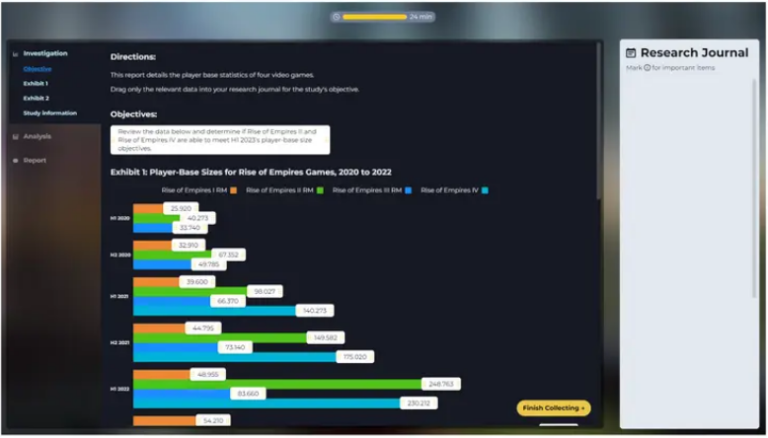The McKinsey Problem-solving Game is a gamified assessment used by McKinsey&Co in the first round of screening applicants. The game was officially launched in 2017 and used more widely in 2020. In 2021, the Solve game replaced the PST (Problem-solving Test) in virtually every McKinsey office. Now, as of March 2023, some participants have mentioned changes in the game’s material.
This article will give updates on the McKinsey Solve game and collect the experiences of people who have gone through the Solve game, as well as their advice on what to do on the test day.
A Brief Overview of the McKinsey PSG
The McKinsey Problem-solving game’s structure
The McKinsey PSG is confirmed to have 6 mini-games:
- Ecosystem Building: constructing an ecosystem in a defined area while taking into account a number of different factors.
- Plant Defense: Utilizing predators to defend a rare plant from animals
- Disaster Management: recognizing when a natural disaster will affect a particular environment and taking action to protect that ecosystem.
- Disease Management: diagnosing infectious diseases, understanding their transmission mechanisms, and estimating their spread within an ecosystem
- Migration Management: guiding a group of animals from one location to another while losing the least amount of animals possible
- Redrock Study: reviewing primary goals and addressing concerns of a business by analyzing data and clarifying the research results through visuals.
Candidates are required to solve 2 out of these 6 mini-games. The total time allotted to finish both games is 71 minutes, which also covers the time needed to read the instructions.
Latest Updates on the McKinsey Solve Game
Starting from March 2023, many players have reported a change in the PSG line-up. Specifically, the Plant Defense game has been gradually replaced by the Redrock Study simulation. This means that test-takers from now on should expect to play the Ecosystem Building and Redrock Study game in the official McKinsey Solve game.
In addition, there has also been an update on the contents of the Redrock Study game itself. Before replacing the Plant Defense game, the Redrock Study simulation consists of three stages: investigation, analysis, and report (you can find out more in this article). However, since the recent update, McKinsey has added a new segment to the simulation – a 10-question mini-case directly related to the study stages context.
The time limit for the Redrock Study assessment is 25 minutes. Although from late March 2023, some players have reported having 35 minutes for both the study stages and the mini-case.

Applicants’ experience with the McKinsey Solve Game
The general consensus among people who are experienced with McKinsey’s recruiting process is that there’s nothing for certain. It’s all about situational thinking and future planning. The latest changes caught a lot of applicants off-guard, which directly affected their performance on the test.
Ecosystem Building and Redrock Study are, for now, the two main minigames most likely to come up in the real Solve game. However, many still hold doubts over the certainty of this, believing that since the Redrock Study game appeared so suddenly, it could also disappear just as quickly.
Ecosystem Building
The Ecosystem Building game is a classic among the PSG minigames, with many online resources to practice with.
In Ecosystem Building, the main focus is on building a “sustainable ecosystem” with 8 species from a list of 40. The Ecosystem Building mini-game presents a unique challenge in that it requires the test-taker to prioritize tasks efficiently and process a large volume of data.
One popular method to overcome this is note-taking using Excel. Excel is most useful for organizing and tabulating all species at a chosen condition. For this reason, some candidates also recommend using two computers, one for playing the game and one for the Excel sheet. Though most prefer using Excel to categorize all information and then do the calculations with pen and paper.
Redrock Study
The new mini-case component of the assessment has been met with both enthusiasm and trepidation by the players. While some players find the additional challenge to be stimulating, others are concerned that the extra time pressure will make it more difficult to answer all 10 questions correctly.
Overall, time pressure is a big factor in this game. Most reported not actually finishing all the case questions in time. The most common advice from those who played Redrock Study seems to be: read the question first then look at the presented data, it will be much faster if you know what you’re looking for.

Test-taking tips
Don’t overthink the game
Sometimes, being too cautious can have the opposite effect. If you take too long to answer a question or take too much time to double-check your work, the software may interpret this as a sign of doubt and hesitation, which could lead to a lower score. It’s important to find a balance between being thorough and cautious while still working quickly and confidently.
Developing a structured, analytical approach to problems is essential for success on the test. If you can demonstrate this to the software, then you will be able to forget the measurements and concentrate solely on the problem-solving aspect.
Be careful where you brainstorm
However, you should still be mindful of the software’s perception of you. Make sure you are navigating through the info panels in a logical way, and that your mouse cursor is not meandering around the screen aimlessly when you are trying to come up with ideas. Ultimately, you should be acting in a way that conveys a sense of purpose and focus.
Using paper or a spreadsheet to brainstorm will also help you organize your ideas and come up with the best solution. This can help you fine-tune your approach and keep your options open. Additionally, you’ll be able to think more deeply about the problem and come up with more creative solutions.
